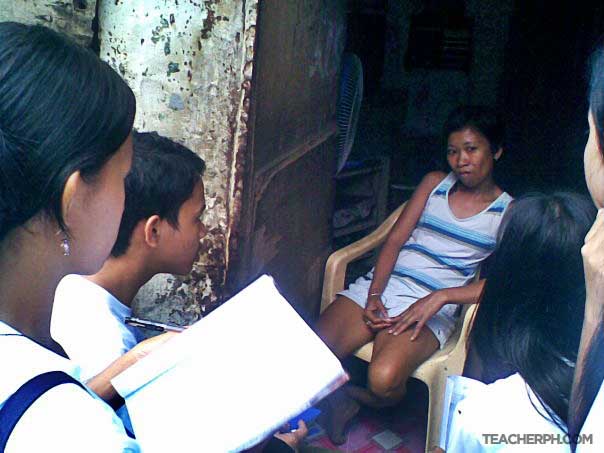Children need to be given all the opportunities to learn in order to acquire skills and abilities to fully develop their potentials. Good health and proper nutrition give children greater ability to learn and do more, thereby enhancing their physical, intellectual, social, emotional and moral development. Nutritionally at risk children are already handicapped in terms of learning abilities and even opportunities.
Children need a diet sufficient in macro and micronutrients. Macronutrients refer to the three essential nutrients – carbohydrates, fats and protein – needed by the body in large amounts to provide the vital energy and body building elements for survival and development. Micronutrients on the other hand, are essential vitamins and minerals needed by the body in minute amounts to regulate physical and mental development. With micronutrient malnutrition on hidden hunger, people become brain-damaged, blind or anemic for want of small amounts of iodine, vitamin A or iron in their daily diet. Inadequate nutrition impairs cognitive development and is associated with educational failure among impoverished children. Recent research findings show that malnutrition can affect brain development over a longer period of a child’s development. Malnutrition also affects emotional development and the capacity to cope with stress.
The latest national nutrition survey reveals that the total prevalence of underweight Filipino pre-schoolers is 33%. About 8% of school children are moderately and severely underweight while 20% are mildly underweight. Even mild undernutrition affects learning. The survey also revealed that iron deficiency anemia (IDA) is the most widespread nutritional deficiency in the Philippines affecting 20 million Filipinos including 30.8% of school children and 26.7% of pre-schoolers.
A recent study of the Nutrition Center of the Philippines (NCP) shows that aside from malnutrition, the leading ailments of school children are decayed teeth and infections of the skin, throat and ears. While they may look trivial, decayed teeth and infections of the skin, throat and ears may have devastating effects on the heart and kidney. These ailments have a disabling effect on the physical and mental capacity of school children.

About 84.40% of school children are infected with intestinal parasites. Six out of ten Filipino children have at least one type of worm. Intestinal worm infestation results to IDA and has shown to decrease physical fitness and activity, work capacity and productivity. They retard growth and impair school performance. Decreased learning capacity and increased absenteeism are common among affected school children.
These revelations of various research studies call for greater partnership between and among parents, educators and other concerned sectors to work together in improving the health and nutrition of children that they may acquire quality education and be better prepared for life ahead.
Table of Contents
What Parents Can Do
Acquire knowledge and skills in health and nutrition
Children learn healthy lifestyle and sound nutritional habits through their parents or caregivers. Parents should read, learn, update and discover helpful information about health and nutrition. More information can be obtained by attending parents classes, participating in community fora, visiting the health sector, listening to the radio and watching TV and taking opportunity in enrolling in non-formal education of DEPED.
The Department of Education (DEPED) project on strengthening the health and nutrition in the school through the teacher-child-parent (TCP) approach has designed, developed and implemented a workbook intended for the child and parents. The child and the parents, through a well-designed guidebook, can work scientifically towards attaining better knowledge and practices on health and nutrition. Invest on the workbook whenever it is available. Work and study with your child in the home and in the school.
Apply quality child care and feeding.
Discover, learn about and monitor the health and nutrition status of your child. Seek and visit health centers and clinics to establish the baseline health and nutrition status of your child or for early case finding. The early case finding of health and nutrition disorders will prevent serious consequences and at the same time enhance the learning opportunity of the child, devoid of physical and mental stress.
Prevent the undernutrition of children by providing them adequate food, emotional security, clean and peaceful home environment, health care and protection. An adequate nutritious breakfast as well as lunch during school days provide the child endurance and better cognitive performance in school.
Support your child’s health and nutrition education.
Assist in your child’s homework as well as in health and nutrition projects such as home gardening and food processing and preservation. Take active part in the health and nutrition activities of the parents-teachers association.
Save and invest on acquiring children’s workbook or parents’ health and nutrition homeguide manual available at the DEPED for ready and long-term references at home.
Strengthen the home and the family.
Make your home an enabling environment that provides children sustenance for sufficient nourishment. Provide health protection against drugs and accidents. Offer opportunities for age-appropriate psycho-social and cognitive stimulation to build their confidence and capability in achieving their full potentials.
Understand fully the health and nutrition needs in the life of a child.
Of all the age groups, infants and pre-schoolers are the most nutritionally at risk. The lack of adequate complementary foods after six months and the high infection rate in this age group contribute to high prevalence of undernutrition. Most undernourished children are below two years of age when growth is accelerating and the brain is on the last stretch of cell development.
The first six years of life is a period of rapid physical and intellectual growth, hence the high nutritional demand. Children at this age are unable to fend for themselves and are almost entirely dependent upon caregivers for their nutrition. They are also prone to infections because of their still underdeveloped immune system, a condition which is in turn aggravated by malnutrition and unsanitary environment.
School children, especially the adolescents among them, are also vulnerable to malnutrition because of the pubertal growth spurt which increases the demand for calories and other nutrients. When children are protected against micronutrient deficiencies, their capacity to learn is ever more enhanced.

What Educators Can Do
Learn, review, update health and nutrition knowledge and skills.
Seek and read references. Visit the libraries and health centers. Attend health and nutrition seminars. Interact with nutrition and health educators. Try the distance learning approach to get updated information on health and nutrition.
Update your knowledge and hone your skills in teaching health and nutrition with the use of the Teachers’ Guide which is developed, tested and implemented by DepEd for the TCP approach in strengthening the health and nutrition curriculum in the School.
Make the school a social laboratory for health and nutrition
Create a scientific environment in the school conducive for children to experiment on food production, processing and preservation. Let activities like establishing plant nurseries, gardening and in-land fish culture provide learning experiences on conservation, biodiversity, waste recycling, sanitation and water management.
Make the school kitchen an experimental station for operationalizing the Philiprpine Plan for Action for Nutrition (PPAN), 2011-2016. As the country’s master plan for achieving nutritional adequacy for Filipinos by the year 2016, the PPAN’s five impact programs namely hunger, child undernutrition, maternal undernutrition, deficiencies in iron, iodine and vitamin A, obesity and overweight. Make the school kitchen a laboratory for boys and girls to experiment and learn how to prepare complementary foods for infants, micro-nutrient rich meals, as well as low-cost but nutritious and easy to prepare dishes.
Ensure the periodic health and nutrition assessment of children.
Establish or strengthen parents-teachers coordinated effort to assess children’s health and nutritional status at the beginning and periodically throughout the school year. The health workers, the school nurse, and the teachers themselves can do rapid assessment of the health and nutrition status of children at the very start of the school year. This screening method ensure early case finding of children suffering from deficiencies and disorders and thus facilitates intervention of referral, thereby preventing disabilities which handicap children’s learning ability.
Innovate to strengthen health and nutrition education.
Teachers training curriculum should be updated, reviewed and enriched with new discoveries in the area of health and nutrition. Teachers guide in integrating new knowledge and skills in health and nutrition into appropriate subjects should be widely encouraged and supported. Develop health and nutrition teaching tools.
With the electrification of even the most remote barangay, public schools can use modern electronic technology, audio-visual, and computers in disseminating key nutrition concepts and practices. Utilize the Internet for quick access to information on recent scientific knowledge and methods.
Link school and home
Extend heath and nutrition knowledge and skills beyond the child to the parents. Strengthen the relay of health and nutrition messages to the home and from the home to the school. Strengthen also the home-room approach of the parents-teachers association.
Provide non-formal or continuing education. There is a need to educate not only the child but also the parents. Health and nutrition education should not be addressed to the mother alone but to both parents. Parents should get health and nutrition education even before the child goes to school. The effectivity of parents as health and nutrition caregivers to their children depends upon the knowledge and education they obtained.
Emphasize in teaching value formation the importance of providing a nurturing home environment for children.
Emphasize that both boys and girls, the parents of the future, are to share more fully in the most difficult and important of all tasks – ensuring the total development of children, thereby also enhancing their intellectual capacities.
Teach parents and adolescent boys and girls the importance of ensuring the adequacy of macro and micronutrients during pregnancy and lactation for the mental and physical development of children. The concept of mental feeding or psychosocial stimulation in early child development also needs to be imparted upon parents and would be parents.
Ensure that the educational system gives emphasis not only to literacy but also to a health mind and body as well as to becoming a socially well adjusted person.
Take the challenging task of making nutrition education the most cost-effective health intervention. As early as kindergarten, teach health lifestyle and sound nutritional practices to children to prepare them ahead for quality basic education. The quality of the parents’ health and nutrition knowledge also depends upon what they get from basic education at school.

What Other Sectors Can Do
The health sector at the local level can be proactive in linking and coordinating with the local DEPED.
School children, constituting a large part of the total population, manifest the public health problems of a population. When a rural health unit provides health services to school children, it becomes a very important link for assessment and intervention for health and nutrition protection in the home and in the community.
Increase and improve program support for women.
This will eventually boost intellectual development of children. There should be programs not just for mothers but also for adolescent girls to build up their nutritional reserves and stock of knowledge for their future adult roles in economic production and family reproduction.
Nutrition for child development is not only a food-based concern but of emotional support and intellectual stimulation as well. Healthy children are generally cheerful, alert, enthusiastic, energetic and intelligent. Let us all work together to promote the physical, emotional and intellectual capacity of school children. This is a direct way of ensuring a productive and peaceful nation.
References:
Florentino S. Solon. Nutrition Center of the Philippines.
The Medium-Term Philippine Plan of Action for Nutrition 2011-2016. Retrieved from: http://www.nnc.gov.ph/plans-and-programs/ppan
Janryll Fernandez. (2010/07/24). Malnutrition among Filipino kids up. Philippine Daily Inquirer. Retrieved from: http://opinion.inquirer.net/inquireropinion/talkofthetown/view/20100724-282969/Malnutrition-among-Filipino-kids-up
Statistics | At a glance: Philippines | UNICEF. Retrieved from: http://www.unicef.org/infobycountry/philippines_statistics.html
Luistro orders strengthening of health and nutrition programs in schools. Retrieved from: http://www.gov.ph/2011/07/06/luistro-orders-strengthening-of-health-and-nutrition-programs-in-schools/
Claire Delfin. (2013/02/27). More than half million Pinoy kids suffer from severe malnutrition. Retrieved from: http://www.gmanetwork.com/news/story/296884/news/specialreports/more-than-half-million-pinoy-kids-suffer-from-severe-malnutrition